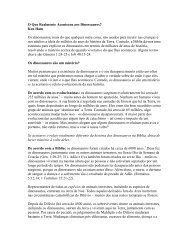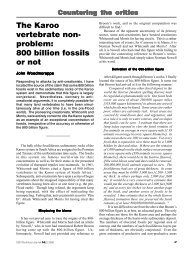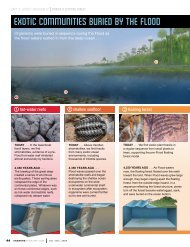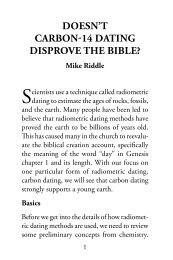Determining the Ark Kinds - Answers in Genesis
Determining the Ark Kinds - Answers in Genesis
Determining the Ark Kinds - Answers in Genesis
You also want an ePaper? Increase the reach of your titles
YUMPU automatically turns print PDFs into web optimized ePapers that Google loves.
198<br />
Cognitum<br />
A cognitum is a group of organisms that are<br />
naturally grouped toge<strong>the</strong>r through human cognitive<br />
senses. A cognitum can be above <strong>the</strong> level of <strong>the</strong><br />
baram<strong>in</strong> (for example, mammals), below <strong>the</strong> level<br />
of <strong>the</strong> baram<strong>in</strong> (for example, foxes), or at <strong>the</strong> level<br />
of <strong>the</strong> baram<strong>in</strong>. This perception-based concept was<br />
proposed by Sanders and Wise (2003) as a separate<br />
tool <strong>in</strong> baram<strong>in</strong>ology. Though not orig<strong>in</strong>ally proposed<br />
as a means to identify baram<strong>in</strong>s, <strong>the</strong> basic concept<br />
could prove useful for our purposes here. Use of this<br />
method assumes that created k<strong>in</strong>ds have reta<strong>in</strong>ed<br />
<strong>the</strong>ir dist<strong>in</strong>ctiveness even as <strong>the</strong>y have diversified.<br />
Human cognitive senses <strong>in</strong>fluence where animals<br />
are placed taxonomically. To some degree a cognitum<br />
approach is used <strong>in</strong> baram<strong>in</strong>ologic studies, though<br />
not always consciously acknowledged. Lightner<br />
(2006) used it when propos<strong>in</strong>g that all members of<br />
<strong>the</strong> genera Ovis and Capra belonged to <strong>the</strong> same<br />
baram<strong>in</strong>. Hybrid data had connected most members<br />
across <strong>the</strong>se genera, and <strong>the</strong> members who had no<br />
hybrid data naturally fit <strong>in</strong> <strong>the</strong> group based on <strong>the</strong>ir<br />
physical appearance. They also happened to fit <strong>in</strong> <strong>the</strong><br />
same group taxonomically.<br />
The cognitum has played a role <strong>in</strong> determ<strong>in</strong><strong>in</strong>g<br />
what is accepted as true hybridization. As discussed<br />
previously, fertilization is clearly <strong>in</strong>sufficient<br />
evidence of hybridization. When Lightner (2007)<br />
found documented evidence that domestic cattle (Bos<br />
taurus) had been crossed <strong>in</strong> vitro with water buffalo<br />
(Bubalus bubalis) and a few fertilized eggs survived<br />
to <strong>the</strong> well-developed blastocyst stage, it seemed<br />
sufficient coord<strong>in</strong>ated expression of genes had been<br />
demonstrated. The fact that water buffalo naturally<br />
group with cattle based on anatomy, physiology, and<br />
<strong>the</strong> husbandry practices used with <strong>the</strong>m was an<br />
important part of why it was accepted. If a blastocyst<br />
could be formed between domestic cattle and a skunk,<br />
this criterion would no doubt be reconsidered.<br />
From previous work <strong>in</strong> baram<strong>in</strong>ology, researchers<br />
have suggested that <strong>the</strong> level of <strong>the</strong> baram<strong>in</strong> tends<br />
to fall at or near <strong>the</strong> taxonomic level of family (Wood<br />
2006). There is often a strong cognitum at <strong>the</strong> family<br />
level. This suggests that <strong>the</strong> family is a good <strong>in</strong>itial<br />
approximation of <strong>the</strong> level of <strong>the</strong> baram<strong>in</strong>. In some<br />
<strong>in</strong>stances a strong cognitum may be above or below<br />
this level. For example, pigs (Suidae) and peccaries<br />
(Tayassuidae) form a strong cognitum even though<br />
<strong>the</strong>y are <strong>in</strong> separate families. From look<strong>in</strong>g at <strong>the</strong>se<br />
animals or pictures of <strong>the</strong>m, <strong>the</strong>y are easily grouped<br />
toge<strong>the</strong>r by human cognitive senses. Their division<br />
<strong>in</strong>to separate families is based on more subtle details,<br />
J. K. Lightner, T. Hennigan, G. Purdom, and B. Hodge<br />
and most people would not naturally split <strong>the</strong>m <strong>in</strong>to<br />
<strong>the</strong>se group<strong>in</strong>gs unless <strong>the</strong>y were familiar with<br />
<strong>the</strong> taxonomy of <strong>the</strong>se animals. So <strong>in</strong> this case <strong>the</strong><br />
baram<strong>in</strong> appears to be at <strong>the</strong> level of <strong>the</strong> superfamily<br />
(Suoidea).<br />
Statistical baram<strong>in</strong>ology<br />
Although developed separately, statistical<br />
baram<strong>in</strong>ology has similarities to <strong>the</strong> cognitum <strong>in</strong> some<br />
ways. It takes a collection of characteristics (character<br />
traits) and us<strong>in</strong>g several statistical tests attempts to<br />
discern significant holistic cont<strong>in</strong>uity (similarity) or<br />
discont<strong>in</strong>uity between species (Wood et al. 2003).<br />
Like <strong>the</strong> cognitum, it assumes that baram<strong>in</strong>s reta<strong>in</strong><br />
<strong>the</strong>ir dist<strong>in</strong>ctiveness today. However, <strong>in</strong> contrast to<br />
<strong>the</strong> cognitum, it assumes that <strong>the</strong> baram<strong>in</strong> is <strong>the</strong> level<br />
where statistical tests will consistently po<strong>in</strong>t when a<br />
set of character traits are analyzed.<br />
Follow<strong>in</strong>g <strong>the</strong> <strong>in</strong>troduction of statistical<br />
baram<strong>in</strong>ology <strong>the</strong> def<strong>in</strong>ition of <strong>the</strong> term holobaram<strong>in</strong><br />
was changed. Essentially, a holobaram<strong>in</strong> can be<br />
thought of as all members of a specific created<br />
k<strong>in</strong>d; <strong>in</strong> o<strong>the</strong>r words, <strong>the</strong> whole baram<strong>in</strong>. Now, a<br />
holobaram<strong>in</strong> is def<strong>in</strong>ed as a group of organisms that<br />
share cont<strong>in</strong>uity, but are bounded by discont<strong>in</strong>uity.<br />
Cont<strong>in</strong>uity is def<strong>in</strong>ed as significant, holistic similarity<br />
between two different organisms (Wood et al. 2003). A<br />
precise def<strong>in</strong>ition of holistic and significant has been<br />
somewhat elusive, so Wood (2007) has po<strong>in</strong>ted out <strong>the</strong><br />
importance of draw<strong>in</strong>g tentative conclusions based on<br />
<strong>the</strong>se statistical tests.<br />
Previously, a holobaram<strong>in</strong> was only identified after<br />
considerable detailed study <strong>in</strong>volv<strong>in</strong>g multiple l<strong>in</strong>es<br />
of evidence. This meant <strong>the</strong> term carried a def<strong>in</strong>itive<br />
connotation. A group was not called a holobaram<strong>in</strong><br />
until a substantial amount of support<strong>in</strong>g evidence was<br />
amassed. This is not <strong>the</strong> case when a holobaram<strong>in</strong><br />
is identified based on statistical tests from a s<strong>in</strong>gle<br />
dataset, even though a dataset may <strong>in</strong>clude many<br />
character traits. This dramatic shift <strong>in</strong> <strong>the</strong> level of<br />
certa<strong>in</strong>ty associated with <strong>the</strong> term holobaram<strong>in</strong> is<br />
often not appreciated by creationists who don’t use<br />
<strong>the</strong>se statistical methods.<br />
There are some clear advantages of statistical<br />
baram<strong>in</strong>ology. A suitable matrix of characters is often<br />
available toge<strong>the</strong>r with published cladistic analyses<br />
of taxonomic groups. S<strong>in</strong>ce someone else has done <strong>the</strong><br />
work of compil<strong>in</strong>g <strong>the</strong> data, <strong>the</strong> baram<strong>in</strong>ologist can<br />
enter it <strong>in</strong>to a spreadsheet and run it through <strong>the</strong><br />
software package available at <strong>the</strong> Center for Orig<strong>in</strong>s<br />
Research (CORE) website. 4 These advantages have<br />
allowed for numerous datasets to be analyzed, add<strong>in</strong>g<br />
4 Available onl<strong>in</strong>e at http://www.bryancore.org/resources.html. The BDISTMDS software package does not need to be downloaded; <strong>the</strong><br />
data is entered directly from <strong>the</strong> spreadsheet. It allows for calculation of baram<strong>in</strong>ic distance correlation and bootstrapp<strong>in</strong>g, for determ<strong>in</strong><strong>in</strong>g<br />
<strong>the</strong> robustness of <strong>the</strong>se correlations. It also performs multidimensional scal<strong>in</strong>g which can be viewed <strong>in</strong> 3D via a downloadable program<br />
called MAGE.







